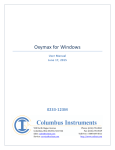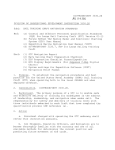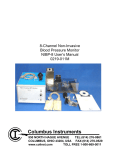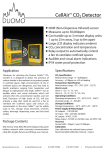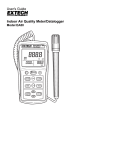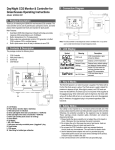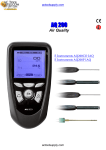Download Table of Contents - Columbus Instruments
Transcript
0215-003M Portable O2/CO2/CH4 Meter User’s Manual Columbus Instruments 950 NORTH HAGUE AVENUE TEL:(614) 276-0861 COLUMBUS, OHIO 43204, USA FAX:(614) 276-0529 1 www.colinst.com TOLL FREE 1-800-669-5011 2 Table of Contents 1. Introduction ........................................................................................................................4 1.0 1.1 1.2 1.3 Overview ................................................................................................................................ 4 Specifications ......................................................................................................................... 5 Front Panel Controls .............................................................................................................. 6 Rear Panel Controls................................................................................................................ 7 2. Safety Considerations ........................................................................................................7 3. Theory of Operation ..........................................................................................................8 4. Operation ............................................................................................................................9 5. Calibration ........................................................................................................................10 6. Maintenance .....................................................................................................................13 6.0 Battery ........................................................................................................................13 6.1 Gas Filter ....................................................................................................................14 3 1. Introduction 1.0 Overview The Columbus Instruments portable gas meter (PGM) can be purchased in several configurations, and various gas concentrations. A. B. C. D. E. F. O2 Measurements CO2 Measurements CH4 Measurements O2 and CO2 Measurements CO2 and CH4 Measurements O2/CO2/CH4 Measurements The Columbus Instruments portable O2/CO2/CH4 Meter uses infrared gas analyzers for CO2 and CH4 and an O2 fuel cell to measure a wide range of gas concentrations. When the analyzer is turned on, the internal pump pulls gas through the sample filter at the front panel and exhausts the sampled gas out the connector on the rear panel. The large LCD display shows the percentage of specified gas concentration. The user can display O2/CO2/CH4 readings on the LCD panel by turning the gas switch to the gas to be inspected. The LCD panel also displays the battery voltage when the user pushes the Battery button on the front panel. The fully charged 12 V battery can operate continuously for at least 12 hours with O2 and CO2 sensors and 8 hours with O2, CO2 and CH4 sensors. 4 1.1 Specifications CO2 Measuring Range: 0-100% (Other ranges available on request) O2 CH4 0-100% 0-100% Accuracy: ±2% of range ±1% of range ±2% of range Resolution 0.1% 0.1% 0.1% Stability (over 12 months): <±2% of range <±2% of range Response Time (0 to 90% at 14 min. air sample flow): 10 sec. 10 sec. affected 12 sec. Humidity: unaffected If not condensing unaffected if not condensing Sensor Life infinite Display: large (0.4”/10.2mm), enhanced-contrast LCD, 00.0~99.9% Operating Temperature: 5-40°C Sample Gas Pump: Internal Gas Flow Rates: 1 LPM (approx.), small O2 sample flows available which will lengthen response time Warm-up Time: Operational: 1min Full Specification: 30 minutes Power Consumption: 12VDC, 6W Fuse: 2 ampere, slow blow Dimensions: Meter: 2.95” X 7.87” X 11.02” (75 X 200 X 280mm) Battery: 8.25” X 2.88” X 6.50” (210 X 73 X 165mm) Weight: Meter: 4 lbs. (1.82 kg) Battery: 7 lbs. (3.18 kg) Rechargeable Battery: 12V, 6 Amp-Hours in separate pack Charger: 115V or 220V 50/60 Hz (Please specify voltage) AC Power Supply: Meter can be operated from the AC 115/220V power line when equipped with an optional power line supply. approx. 5 years(20°C) infinite 5 1.2 Front Panel Controls 1. Battery Check Button –The LCD (#3) displays the battery voltage, when pressed. 2. O2 Span Calibration – 10 turn dial for adjusting the span of the O2 during calibration. 3. LCD Display – This displays the analyzer results of the gas specified by Switch (#4). When the Battery Check Button (#1) is pushed, battery voltage is displayed. 4. O2/CO2/CH4 Switch – Selects the gas to be analyzed. (2-position toggle switch for 2 gas units, 3-position switch for 3 gas units). 5. Sample Gas Inlet – ¼” ID air fitting, always connect the external gas filter here. 6. Power Indicator – This green LED is lit when power to the meter is on. 7. Power Button – Push the button to turn the power on, the Power Indicator LED will light up, push this button again to turn the power off. 6 1.3 Rear Panel Controls 1. SAMPLE OUT – Bulkhead air fitting. This is the output for sampled gasses. Attaching tubing to this bulkhead connector can collect the exhaust gas. 2. 3 Pin Din Connector – Power cord receptacle. 3. Fuse − Replace with a 2 amp. slow blow fuse. 2. Safety Considerations The Columbus Instruments O2/CO2/CH4 Portable Gas Meter is designed to operate in typical field environments where flammable gases may be present. However, it is not certified intrinsically safe and the following points should be observed during operation: • Do not operate the unit if it is damaged in any way (i.e. broken case, loose front panel, missing screws etc.). • Do not connect or remove plugs from the auxiliary connector where flammable gases may be present. • Only charge the battery using the supplied charger. • Do not operate the unit in a confined space where the flammable gases may be present. 7 3. Theory of Operation The Columbus Instruments O2/CO2/CH4 Portable Gas Meter incorporates infrared CO2/CH4 sensors and a GS oxygen sensor. The infrared sensor optics comprises a robust infrared source, a gas sampling cell, two infrared filters and a matched twin element detector. The infrared source is the hot filament of a tungsten lamp emitting a broad band of radiation that is then guided through the gas in the sample cell. The radiation then passes through either of two filters. The two filters are selected so that one is coincident with the gas to be measured and the other is independent of any gas likely to present in the cell. In the absence of CO2 gas the energy reaching the two detectors is equal and at a maximum and as the sample gas concentration increases the amount of infrared radiation reaching the two detectors differs due to absorption at one filter wavelength only. The microprocessor gives the gas concentration, automatically compensated for source intensity changes or contamination of the optical elements. The output signal from the CO2 sensor is proportional to CO2 concentration. The GS oxygen sensor incorporates a lead oxygen cell with a lead cathode, using a specific acid electrolyte. Oxygen molecules diffuse through a non-porous Teflon membrane in to the electrochemical cell and are reduced at the gold electrode. The current flowing between the electrodes is proportional to the oxygen concentration in the gas mixture to be measured. The signals are measured as terminal voltages of the resistor and the thermistor for temperature compensation. The change in output voltages represents the oxygen concentration. 8 4. Operation It is the user’s responsibility to ensure that the gas supplied to O2/CO2/CH4 Meter is clean and free from particulate matter. Even in relatively clean “office” environments, the air will contain significant amounts of particulate matters that should be removed by external filtering. It should also be noted that the humidity level remain below that required for condensation to occur. Always connect the external gas filter to the gas inlet on the front panel before turning on the power. Do not reverse air filter terminals, as this will cause dust particles trapped in the filter to be blown into the gas sensor. 1. Plug one end of the supplied power cord into the socket on the battery pack and the other end into the 3 Pin Din Connector on the rear panel of the Meter. 2. Push the Power Button on the front panel, the green LED will light up and the internal pump will start to run. 3. Let the Meter warm-up for about 1 minute. 4. Calibrate the oxygen sensor follow the procedure in the “Calibration” section. If user wants to only measure the CO2 or CH4 concentration, it is not necessary to calibrate the oxygen sensor. 5. Turn the power off when the experiment is finished. 6. Recharge battery. 9 5. Calibration The Columbus Instruments O2/CO2/CH4 Meter uses a galvanic oxygen sensor and a NDIR carbon dioxide and/or CH4 sensors to measure gas concentrations. The ideal test gas for zero point calibration is pure nitrogen (N2). Ambient air is not recommended for calibrating the CO2 sensor because of its CO2 content, unless CO2 is removed from the air by soda lime CO2 absorbing trap. The material of the gas inlet pipe can be nylon, PVC or neoprene; never use silicon rubber as this can effect the gas concentration. The inlet pipe should not be longer than 6’ (2 meters) to ensure rapid response. 1. Calibration Intervals: For the CO2 and CH4 sensor we recommend the calibration to be checked every 12 months. For the O2 sensor we recommend that the zero point to be checked every 12 months and the span point to be checked with ambient air before each experiment. 2. Zero gases: The ideal test gas for zero point calibration is pure nitrogen (N2). This allows the user to check the zero point for both of gases. One can also use air, with the CO2 removed by soda lime trap. 3. Span Gases: For the CO2/CH4 sensor, the CO2/CH4 concentration in the span gas should be between 80% and 100%. For O2 sensor the user may use clean dry air which is assumed to be 20.93% oxygen. For other gas range appropriate calibration gas concentration should be chosen. 4. To supply gas from a pressurized bottle, a pressure regulator, a needle valve, a gas flow meter and an inlet pipe are required. The output pressure from the regulator should only slightly exceed the ambient pressure. Never connect an unregulated cylinder or other pressure source to the meter, as the high pressure may damage the instrument. The whole calibration system is shown in FIGURE 1. FIGURE 1 − Calibrating Connection 10 5. The following procedure is for checking/adjusting the calibration: 1. The O2/CO2/CH4 Meter should be powered for 30 minutes before checking its calibration. 2. Attach the ZERO gas (N2) to the gas inlet. Adjust the needle valve to provide approx. 1.5 l/min to the instrument and allow the gas to flush a few seconds before checking the reading. If the reading is outside the required specification, open the Meter box, adjust the ZERO potentiometers for both O2 and CO2 (The location of the potentiometers is shown in FIGURE 2). Always make adjustments with ZERO gas (N2) FIRST and then with span gas (CO2 / AIR). FIGURE 2 − Calibration Adjustments Location 3. Supply the span gas source (CO2 or CH4 in AIR) to the gas inlet. Adjust the needle valve to provide 1.5 l/min to the instrument. Wait for a few seconds then adjust the SPAN potentiometers if required for maximum accuracy (the O2 SPAN potentiometer is on the front panel). The bottle concentration should be corrected for pressure. 11 4. The Columbus Instruments O2/CO2/CH4 Meter has the built-in temperature compensation circuit to automatically correct the variations in ambient temperature. The pressure corrections can be calculated as following: Gas Concentration = Bottle Concentration X Pressure (mb) / 1013.25 Where: Bottle Concentration is the Span gas concentration stated on the cylinder. Pressure is the ambient pressure at the time of calibration 1013.25 millibars is standard atmospheric pressure (mb) 760 millimeters of mercury is standard atmospheric pressure. If you prefer to use millimeters of mercury then substitute 760 in place of the 1013.25. Example: If ambient pressure is 980 mb then the corrected span gas concentration for say 80% CO2 span calibration cylinder is: Gas Concentration = 80 X 980 / 1013.25 = 77.4% This means that instead of adjusting the instrument to read 80% at span, it should be adjusted to read 77.4%. 12 6. Maintenance 6.0 Battery The unit uses sealed maintenance free lead-acid batteries. These will give a long reliable life providing they are kept charged. In order to ensure that excessive battery discharge does not occur, the unit is equipped with a battery check button on the front panel so the user can check battery voltage. The battery is charged using the supplied charger. Plug the charger into 120 VAC and insert the large plug on charger’s cable firmly into the battery pack receptacle, the battery pack begins recharging immediately. A full charge of a completely flat battery pack will take at least 16 hours. Optional second battery pack with charger is available which can assure uninterrupted operation at O2/CO2/CH4 Meter. Before using the Columbus Instruments Portable Gas meter, the battery should be completely charged. The battery voltage should be monitored during normal usage of the portable gas meter. Do this by pushing the “BATTERY” button on the front panel to directly read the battery voltage. If the voltage drops below 12 volts the battery should be recharged. It is not recommended to let the battery completely discharge during use of the portable gas meter. The Columbus Instruments Portable Gas Meter uses a switching power supply to maintain a highly regulated internal working voltage in the equipment. As the battery becomes discharged, the battery voltage drops. In seeking to maintain a constant working voltage, the power supply will draw higher current from the batteries. This can cause the fuse to open if the user allows the portable gas meter to completely drain the battery. No damage is done to the portable gas meter or the battery, but the user will have to replace the open fuse. 13 Various battery voltages and likely capacities are summarized bellow: Battery Volts Conditions Likely Capacity Remaining 13.8 to 14.0 Connected to charger after extended charge period 90 to 100% 10 to 20 hrs depending on the level of discharge 12.6 to 12.8 Not connected to charger, power is on 90 to 100% 12.0 to 12.2 Not connected to charger, power is on 30 to 50% 11.8 to 12.0 Not connected to charger, power is on 10 to 20% 11.5 and below close to 0% Not connected to charger, power is on 6.1 Gas filter The supplied gas filters have a relatively long lifetime but care should be taken to keep the “water” away from filter. When the filter’s color turns to pink or is dirty, it should be replaced. 14















